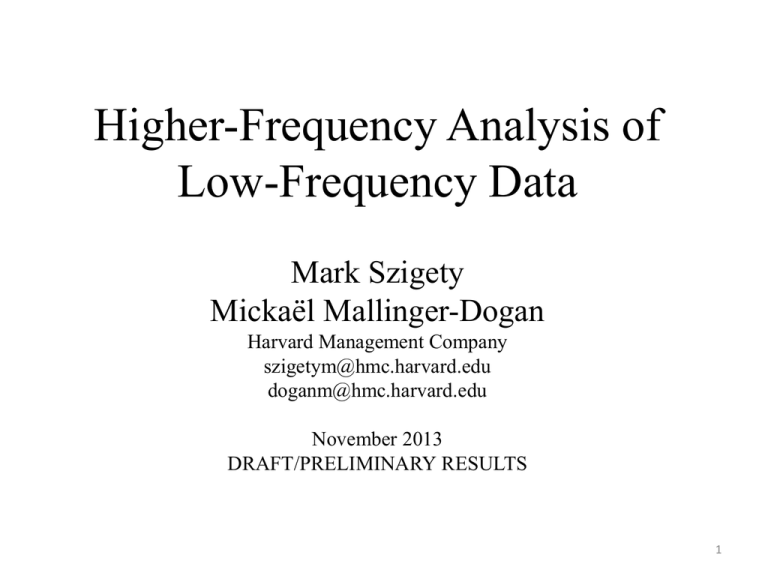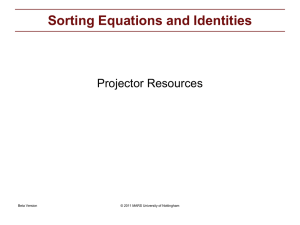
Higher-Frequency Analysis of
Low-Frequency Data
Mark Szigety
Mickaël Mallinger-Dogan
Harvard Management Company
szigetym@hmc.harvard.edu
doganm@hmc.harvard.edu
November 2013
DRAFT/PRELIMINARY RESULTS
1
Problem
• Institutions invest heavily in asset classes characterized by
illiquidity
• Illiquid asset classes are priced at a lower frequency than
public market investments
• Risk measures, rebalancing, and asset allocation often rely on
historical time series
• How do we incorporate all asset classes in a common
analytical framework?
2
Highest Common Frequency
• Convert all series to common frequency, typically quarterly
• Advantages:
– Easy
• Disadvantages:
– Discards information, exacerbated by short evaluation window
– Derived results may not be relevant at decision-making frequency
3
Other Possibilities
• Public markets proxies/Factor assignments
–
–
–
–
Bottoms-up analysis of illiquid holdings
NAV-blend appropriate higher-frequency series
Advantages: Thorough replication of current risks
Disadvantages: Complicated, especially for big portfolios; subjective;
needs to be constantly refreshed; not linked to realized returns
(unsmoothed?)
• Replication of current valuation model(s)
–
–
–
–
Build and calibrate valuation model(s) in-house
Construct time series (or if possible search for analytical solutions)
Advantages: Thorough replication of current risks
Disadvantages: Essentially impossible; model error
4
Interpolation Approaches
• Can we make use of some econometric approaches to the
problem?
• Economists and policy makers face a similar problem when
measuring GDP
• Work on the “distribution” problem began in the 1950s and
continues today
5
Contribution and Findings
• Apply econometric interpolation methodologies to the context
of illiquid investments and institutional risk
• Rigorously compare through simulation the two primarily
relevant interpolation methodologies
• Primary findings:
– The more current methodology tends to excel when the serial
correlation is high and/or the explanatory power of the proxy is high
– The proxy used can affect the risk attribution by changing the
relationship that the interpolated series has to factors
– Whether to interpolate and which to use depends on context
6
Best Linear Unbiased Estimator (BLUE)
The estimator is
where
Assuming
we get
7
Mixed-Frequency VAR (MFV)
Let for all t
Assume a Gaussian VAR(p) model for {y*t}
A state-space representation of the VAR model is
Let for all t
we get
As {y+t} has no missing observations, the Kalman filter and smoother apply directly.
8
Comparison
Year
Description
1)
2)
BLUE: Chow and Lin (CL)
MFV: Mariano and Murasawa (MM)
1971
2003, 2010
Applies low-frequency betas to higherfrequency observations of the proxy(ies)
Distributes estimated residuals
1)
2)
VAR model for partially latent highfrequency series
State-space model for the observable
mixed-frequency series
Pros
1)
2)
3)
Intuitive
Fast
Number of parameters to estimate grows
slowly when more proxies are added
1)
2)
Complex residuals structure built-in
Can estimate multiple low-frequency series
at once
Cons
1)
Very difficult to implement complex
residuals structure (i.e., more than AR(1))
Only estimates one low-frequency series
at a time
Biased(?)
1)
2)
3)
Harder to implement
Slow(er)
Number of parameters to estimate grows
dramatically when a new series is added
and/or the order of the VAR model is
increased
2)
3)
9
Graphical Example: Real Estate
Source: Real Estate Index data from Cambridge Associates, LLC. Copyright 2013. All rights reserved. The Cambridge
Associates, LLC data may not be copied, used, or distributed without Cambridge’s prior written approval. The data is provided
“as is” without any express or implied warranties. Past performance is no guarantee of future results.
10
Simulation Framework
• Three return series are simulated (P, X, F); P is converted to
lower frequency in 3-to-1 ratio
𝑟𝑃𝑡 = µ𝑃 + 𝛾𝑟𝑃𝑡−1 + 𝑒𝑃𝑡
𝑟𝑋𝑡 = µ𝑋 + 𝑒𝑋𝑡
𝑟𝐹𝑡 = µ𝐹 + 𝑒𝐹𝑡
where
ejt ~ N(0, Σ)
𝛴=
σ𝑃𝑃
σ𝑃𝑋
σ𝑃𝐹
σ𝑃𝑋
σ𝑋𝑋
σ𝑋𝐹
σ𝑃𝐹
σ𝑋𝐹
σ𝐹𝐹
• Each methodology is then used to convert P back to higher
frequency, and their relative success is assessed
11
Dimensions of Comparison
• RMSE: measure of the overall accuracy of each candidate
interpolation methodology
• Volatility: useful in a variety of analytical measures of
portfolio risk
• AR(1): impacts proper volatility scaling and could affect the
usefulness of various downstream unsmoothing approaches
• Beta to Factor: useful in preserving relationships heavily relied
upon for factor contribution to risk, correlations, and stress
testing
12
Context of Comparison
• Low/High autocorrelation: does performance vary based on
the level of autocorrelation?
• Low to High explanatory power of proxy: does performance
vary based on the “quality” of the proxy?
• Low to High beta of portfolio to factor: does performance vary
based on the true high-frequency beta of the portfolio to the
factor?
• Minimum/Maximum possible beta of factor to proxy: does
performance vary based on the relationship of the factor to the
proxy?
13
Results: Low AR; Minimum Beta F to X
Dimension
RMSE
Volatility
AR(1)
Beta P to F
Beta F to X
RMSE
Volatility
AR(1)
Beta P to F
Beta F to X
RMSE
Volatility
AR(1)
Beta P to F
Beta F to X
RMSE
Volatility
AR(1)
Beta P to F
Beta F to X
RMSE
Volatility
AR(1)
Beta P to F
Beta F to X
True
Value
0.00%
15.0%
0.20
0.10
0.00%
15.0%
0.20
0.27
0.00%
15.0%
0.20
0.45
0.00%
15.0%
0.20
0.62
0.00%
15.0%
0.20
0.79
CL
2.31%
14.5%
0.36
0.03
0.0
2.31%
14.5%
0.36
0.08
0.0
2.31%
14.5%
0.36
0.13
0.0
2.30%
14.4%
0.35
0.20
0.0
2.31%
14.5%
0.35
0.41
0.4
% of Remaining P Variance Explained by X
30
60
90
MM
CL
MM
CL
2.30%
1.83%
1.74%
1.16%
15.7%
14.0%
15.0%
14.3%
0.48
0.16
0.33
0.06
0.03
0.03
0.03
0.04
0.0
0.0
0.0
0.0
2.30%
1.83%
1.74%
1.16%
15.6%
14.0%
15.0%
14.3%
0.47
0.17
0.32
0.06
0.07
0.09
0.08
0.16
0.0
0.0
0.0
0.1
2.30%
1.82%
1.74%
1.16%
15.7%
14.1%
15.0%
14.3%
0.47
0.17
0.33
0.06
0.12
0.16
0.14
0.34
0.0
0.0
0.0
0.3
2.30%
1.82%
1.74%
1.15%
15.5%
14.1%
15.2%
14.3%
0.46
0.17
0.35
0.06
0.18
0.32
0.28
0.59
0.0
0.2
0.2
0.6
2.29%
1.82%
1.73%
1.16%
15.7%
14.1%
15.1%
14.3%
0.47
0.17
0.34
0.06
0.36
0.63
0.55
0.83
0.4
0.7
0.7
0.9
MM
0.87%
15.0%
0.22
0.03
0.0
0.87%
14.9%
0.22
0.14
0.1
0.87%
14.9%
0.22
0.30
0.3
0.87%
14.9%
0.23
0.52
0.6
0.87%
15.0%
0.23
0.73
0.9
14
Results: Low AR; Maximum Beta F to X
Dimension
RMSE
Volatility
AR(1)
Beta P to F
Beta F to X
RMSE
Volatility
AR(1)
Beta P to F
Beta F to X
RMSE
Volatility
AR(1)
Beta P to F
Beta F to X
RMSE
Volatility
AR(1)
Beta P to F
Beta F to X
RMSE
Volatility
AR(1)
Beta P to F
Beta F to X
True
Value
0.00%
15.0%
0.20
0.10
0.00%
15.0%
0.20
0.27
0.00%
15.0%
0.20
0.45
0.00%
15.0%
0.20
0.62
0.00%
15.0%
0.20
0.79
CL
2.30%
14.3%
0.35
0.34
0.8
2.30%
14.4%
0.35
0.43
0.9
2.31%
14.4%
0.35
0.48
0.9
2.31%
14.4%
0.35
0.53
0.9
2.30%
14.5%
0.36
0.52
0.7
% of Remaining P Variance Explained by X
30
60
90
MM
CL
MM
CL
2.29%
1.82%
1.73%
1.15%
15.6%
14.1%
15.0%
14.3%
0.48
0.16
0.33
0.06
0.29
0.37
0.31
0.28
0.8
0.7
0.7
0.4
2.29%
1.83%
1.74%
1.15%
15.6%
14.1%
15.1%
14.3%
0.47
0.16
0.33
0.06
0.37
0.49
0.42
0.46
0.9
0.8
0.8
0.6
2.30%
1.82%
1.73%
1.15%
15.6%
14.1%
15.1%
14.3%
0.47
0.17
0.34
0.06
0.42
0.61
0.52
0.58
0.9
0.9
0.9
0.7
2.29%
1.83%
1.74%
1.16%
15.6%
14.1%
15.0%
14.3%
0.47
0.16
0.32
0.06
0.46
0.67
0.59
0.77
0.9
0.9
0.9
0.9
2.29%
1.82%
1.73%
1.16%
15.7%
14.1%
15.0%
14.3%
0.48
0.17
0.32
0.06
0.45
0.69
0.62
0.83
0.7
0.8
0.8
0.9
MM
0.87%
15.0%
0.23
0.24
0.4
0.87%
14.9%
0.23
0.40
0.6
0.87%
15.0%
0.23
0.51
0.7
0.87%
15.0%
0.23
0.67
0.9
0.87%
14.9%
0.22
0.73
0.9
15
Results: High AR; Minimum Beta F to X
Dimension
RMSE
Volatility
AR(1)
Beta P to F
Beta F to X
RMSE
Volatility
AR(1)
Beta P to F
Beta F to X
RMSE
Volatility
AR(1)
Beta P to F
Beta F to X
RMSE
Volatility
AR(1)
Beta P to F
Beta F to X
RMSE
Volatility
AR(1)
Beta P to F
Beta F to X
True
Value
0.00%
15.0%
0.70
0.10
0.00%
15.0%
0.70
0.16
0.00%
15.0%
0.70
0.21
0.00%
15.0%
0.70
0.27
0.00%
15.0%
0.70
0.32
CL
1.06%
13.4%
0.58
0.04
0.0
1.08%
13.3%
0.57
0.06
0.0
1.06%
13.4%
0.59
0.08
0.0
1.06%
13.3%
0.58
0.10
0.0
1.07%
13.3%
0.58
0.20
0.3
% of Remaining P Variance Explained by X
30
60
90
MM
CL
MM
CL
0.79%
1.16%
0.60%
1.26%
17.0%
12.0%
16.1%
11.6%
0.83
0.39
0.77
0.26
0.03
0.04
0.03
0.05
0.0
0.0
0.0
0.0
0.79%
1.17%
0.60%
1.26%
17.0%
12.1%
16.0%
11.5%
0.83
0.39
0.77
0.26
0.05
0.07
0.05
0.15
0.0
0.0
0.0
0.2
0.79%
1.17%
0.60%
1.28%
17.1%
12.0%
16.1%
11.6%
0.84
0.39
0.78
0.26
0.06
0.09
0.07
0.26
0.0
0.0
0.0
0.4
0.79%
1.18%
0.60%
1.28%
17.0%
12.1%
16.1%
11.5%
0.83
0.39
0.78
0.25
0.08
0.22
0.14
0.36
0.0
0.3
0.3
0.6
0.79%
1.18%
0.60%
1.26%
17.1%
12.1%
16.0%
11.6%
0.83
0.39
0.77
0.26
0.14
0.34
0.21
0.46
0.3
0.6
0.6
0.8
MM
0.30%
15.2%
0.72
0.03
0.0
0.30%
15.2%
0.72
0.09
0.2
0.30%
15.2%
0.72
0.16
0.4
0.30%
15.2%
0.72
0.22
0.6
0.30%
15.2%
0.72
0.28
0.8
16
Results: High AR; Maximum Beta F to X
Dimension
RMSE
Volatility
AR(1)
Beta P to F
Beta F to X
RMSE
Volatility
AR(1)
Beta P to F
Beta F to X
RMSE
Volatility
AR(1)
Beta P to F
Beta F to X
RMSE
Volatility
AR(1)
Beta P to F
Beta F to X
RMSE
Volatility
AR(1)
Beta P to F
Beta F to X
True
Value
0.00%
15.0%
0.70
0.10
0.00%
15.0%
0.70
0.16
0.00%
15.0%
0.70
0.21
0.00%
15.0%
0.70
0.27
0.00%
15.0%
0.70
0.32
CL
1.08%
13.3%
0.58
0.27
0.9
1.06%
13.3%
0.58
0.28
0.9
1.06%
13.3%
0.58
0.30
0.9
1.07%
13.3%
0.58
0.32
0.9
1.06%
13.4%
0.58
0.30
0.7
% of Remaining P Variance Explained by X
30
60
90
MM
CL
MM
CL
0.79%
1.17%
0.60%
1.25%
17.0%
12.0%
15.9%
11.5%
0.83
0.39
0.77
0.26
0.15
0.31
0.18
0.24
0.9
0.8
0.8
0.5
0.79%
1.17%
0.60%
1.27%
17.0%
12.1%
16.0%
11.6%
0.83
0.39
0.77
0.26
0.17
0.37
0.22
0.35
0.9
0.9
0.9
0.7
0.79%
1.18%
0.60%
1.26%
16.9%
12.1%
16.0%
11.6%
0.83
0.38
0.77
0.26
0.18
0.39
0.23
0.41
0.9
0.9
0.9
0.8
0.79%
1.16%
0.60%
1.26%
17.0%
12.0%
15.9%
11.6%
0.83
0.40
0.77
0.26
0.20
0.41
0.25
0.48
0.9
0.9
0.9
0.9
0.79%
1.18%
0.60%
1.27%
17.2%
12.0%
16.0%
11.6%
0.84
0.38
0.77
0.26
0.19
0.44
0.26
0.50
0.7
0.9
0.9
0.9
MM
0.30%
15.2%
0.72
0.14
0.5
0.30%
15.2%
0.72
0.21
0.7
0.30%
15.2%
0.72
0.24
0.8
0.30%
15.1%
0.71
0.29
0.9
0.30%
15.2%
0.71
0.30
0.9
17
Summary Findings
• The mixed-frequency VAR/MM model performs better than the best
linear unbiased estimator/CL, ceteris paribus, when:
– the AR coefficient increases
– the explanatory ability of the proxy improves
• The relationship between the factor and the proxy dictates how
accurately the beta of the portfolio to the factor will be recovered
ceteris paribus, and which interpolator is best
– In the case of high AR: the higher the beta of F to X, the more accurate the
MFV beta of P to F will be (CL tends to overestimate); low beta of F to X
tends to favor CL
– In the case of low AR: both MM and CL perform similarly
• In some cases, it might not make sense to interpolate at all!
– Low AR, low beta of F to X, low explanatory power…both perform
terribly if you care about factor decomposition and recovering AR…
18
Practical Example: HCF (Quarterly)
5.07%
8.36%
Private
Equity
7.55%
12.45%
Real
Estate
4.70%
7.76%
-0.22
1.00
0.34
-1.20
0.10
-0.44
Portfolio
(45/25/20/10)
7.63%
12.59%
1.38%
0.47
-1.30
47.42%
27.69%
13.49%
22.41%
103.95%
-5.28%
-50.00% 11.11% -17.21%
44.81% -15.00% 18.03%
-5.68%
6.54%
-23.73%
20.67%
15.30%
2.79%
Stocks
Bonds
1.00
-0.81
0.84
0.56
0.99
-0.81
1.00
-0.80
-0.58
-0.79
0.18%
Real
Estate
0.56
-0.58
0.85
1.00
0.63
2010-2012
Stocks
Bonds
Volatility
VaR 95%
TE to 60/40
Beta to Stocks
Beta to Bonds
FPCTR
Stocks
Bonds
Stresses
Stocks
Bonds
8/11 - 9/11
Max Drawdown
18.60%
30.69%
1.00
-2.96
Stocks
Bonds
Private Equity
Real Estate
Portfolio
100.00% 0.00%
0.00% 100.00%
5.40%
Private
Equity
0.84
-0.80
1.00
0.85
0.89
6.35%
Portfolio
0.99
-0.79
0.89
0.63
1.00
Source: Real Estate and Private Equity Index data from Cambridge Associates, LLC. Copyright 2013. All rights reserved.
The Cambridge Associates, LLC data may not be copied, used, or distributed without Cambridge’s prior written approval. The
data is provided “as is” without any express or implied warranties. Past performance is no guarantee of future results. Stocks
and Bonds are represented by Russell 3000 and Barclays US Agg.
19
Practical Example: Interpolation (Monthly)
3.68%
6.07%
Private
Equity
6.73%
11.11%
Real
Estate
3.34%
5.50%
-0.17
1.00
0.34
-1.18
0.13
-0.33
Portfolio
(45/25/20/10)
7.19%
11.86%
1.38%
0.49
-1.43
100.00% 0.00%
0.00% 100.00%
81.35%
-3.06%
22.06%
-3.95%
108.27%
-9.02%
-50.00%
43.28%
-13.29%
17.75%
8.63%
-15.00%
4.58%
2.79%
Stocks
Bonds
1.00
-0.73
0.90
0.45
0.99
-0.73
1.00
-0.71
-0.19
-0.67
-16.93% -5.87%
14.04%
3.23%
-5.58% -0.94%
5.58%
3.24%
Private
Real
Equity
Estate
0.90
0.45
-0.71
-0.19
1.00
0.61
0.61
1.00
0.93
0.54
2010-2012
Stocks
Bonds
Volatility
VaR 95%
TE to 60/40
Beta to Stocks
Beta to Bonds
FPCTR
Stocks
Bonds
Stresses
Stocks
Bonds
8/11 - 9/11
Max Drawdown
15.95%
26.32%
1.00
-3.16
Stocks
Bonds
Private Equity
Real Estate
Portfolio
-24.46%
18.96%
-6.19%
7.23%
Portfolio
0.99
-0.67
0.93
0.54
1.00
Source: Real Estate and Private Equity Index data from Cambridge Associates, LLC. Copyright 2013. All rights reserved.
The Cambridge Associates, LLC data may not be copied, used, or distributed without Cambridge’s prior written approval. The
data is provided “as is” without any express or implied warranties. Past performance is no guarantee of future results. Stocks
and Bonds are represented by Russell 3000 and Barclays US Agg.
20
Open Questions
• When do we decide to use the interpolators, and which one?
– Depends what we care about…
• How do we choose the appropriate proxies?
• Future methodological questions/issues:
–
–
–
–
How to incorporate higher order AR?
How are constraints introduced into the MFV?
Are there any benefits to interpolating multiple low-frequency series?
How effective forecasters are these methodologies?
21
Thank You
Questions?
22









